I go against almost
all the advice on best practice given to farmers.” So Clive Bright tells me as we walk across a sloping field in the hills of Ardsallagh,
Co Sligo.
Clive farms a 120ac suckler-to-beef herd of between 35 to 50 animals. He farms using a method known as Holistic Planned Grazing; a unique system for farming with nature. He sells his beef through his business, Rare Ruminare, via direct sale.
From what he tells me, Clive has never been a “status quo” kind of guy, so it’s no wonder that when it came to his farm, he wanted to find his own way to make things work for himself, his family life (he has two children) and for nature.
Organic interest
“I remember being 12-ish [years of age] and getting the library in Ballymote to order me books on organic farming,” he chuckles. “Whether I had seen a feature about it on TV that inspired me or I don’t know what. But I was always interested in organic farming.”
Clive isn’t just a farmer though, he is also an artist. He studied textile design at the National College of Art and Design in Dublin and had a dream of getting his degree, moving home, getting his Green Cert and living his life both farming and creating art.
At the time, he wasn’t sure how this was going to work, but a chance meeting at 18 (while in hospital with appendicitis) grew his confidence and helped guide his future.
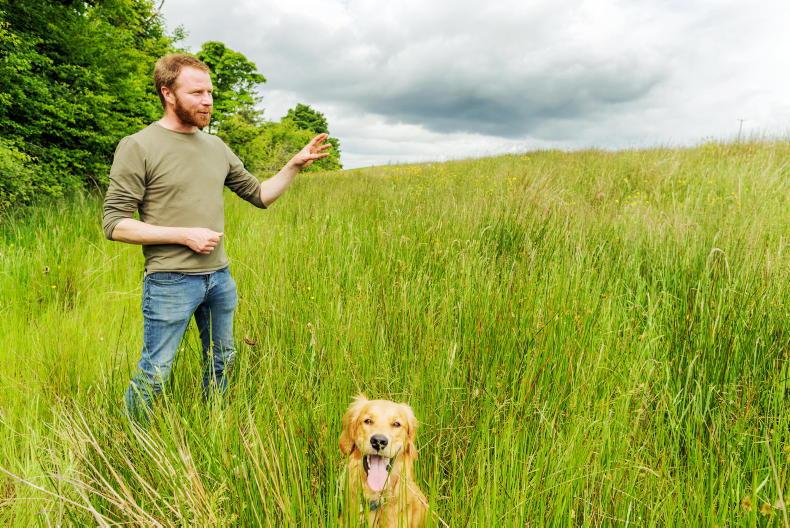
Clive Bright specialises in Planned Holistic Grazing for his beef herd at Rare Ruminaire Farm in Ardsallagh, Co. Sligo / James Connolly
“I met this goldsmith, Erwin Springbrunn, who had pretty much the same formula [art and farming],” he says. “I wanted to be an organic farmer and this guy was an organic farmer and a goldsmith. He was doing exactly what I planned to do, so it was really cool.”
Making the switch
Clive has been farming organically (and with holistic principles) for years, but in 2020, he did formal training in Holistic Planned Grazing and now says he would never look back.
“Previously, I would say my farm was holistic, but it was actually mob grazing and I was adjusting my paddocks all the time,” he explains. “The cattle were healthy but I hit the stage where my productivity was dropping slightly – now it doesn’t; the pastures are pumping with growth all the time.
“The thing about Holistic Planned Grazing is you’re constantly monitoring,” he continues. “You’re monitoring plant density, so the amount of time the cattle are in [the paddock] has an effect and the amount of recovery time also has an effect.

Clive practices adapted breeding, which means he only keeps stock with calm temperaments and those which are self-sufficient / James Connolly
If my recovery is too long at the wrong time of year, none of the new plants have a chance to grow. You have to get the timing right to grow as much grass as you can and allow for all that diversity.”
Holistic Planned Grazing
Holistic Planned Grazing was developed in the 1960s by an African-based biologist named Alan Savory. He found that, while rotational grazing works well for livestock management, it didn’t necessarily provide ecological benefits (especially in southern Africa, where desertification is a problem).
This grazing management system takes animal welfare, nature and productivity into account while adhering to the following principles:
- A necessary understanding of the mutual relationship between humans, animals and the land.
- Enough on-farm flexibility to respond to nature’s ever-changing landscape.
- The idea that, if your farming style mimics nature well enough, animal husbandry can act as a substitute for original grazing herds which might now be lost.
- Understanding that timing is everything – knowing when to graze a certain field, and for how long, is crucial to this agricultural system.
- Monitoring all decisions, and assessing their impact on the four ecosystem processes (watercycle, mineral cycle, energy flow and community dynamics).
Benefits for farmers
Some of Savory’s teachings have been refuted by scientists – for example, he stated in a TED Talk that his method can bring carbon levels back to pre-industrial levels, which some scientists refute.
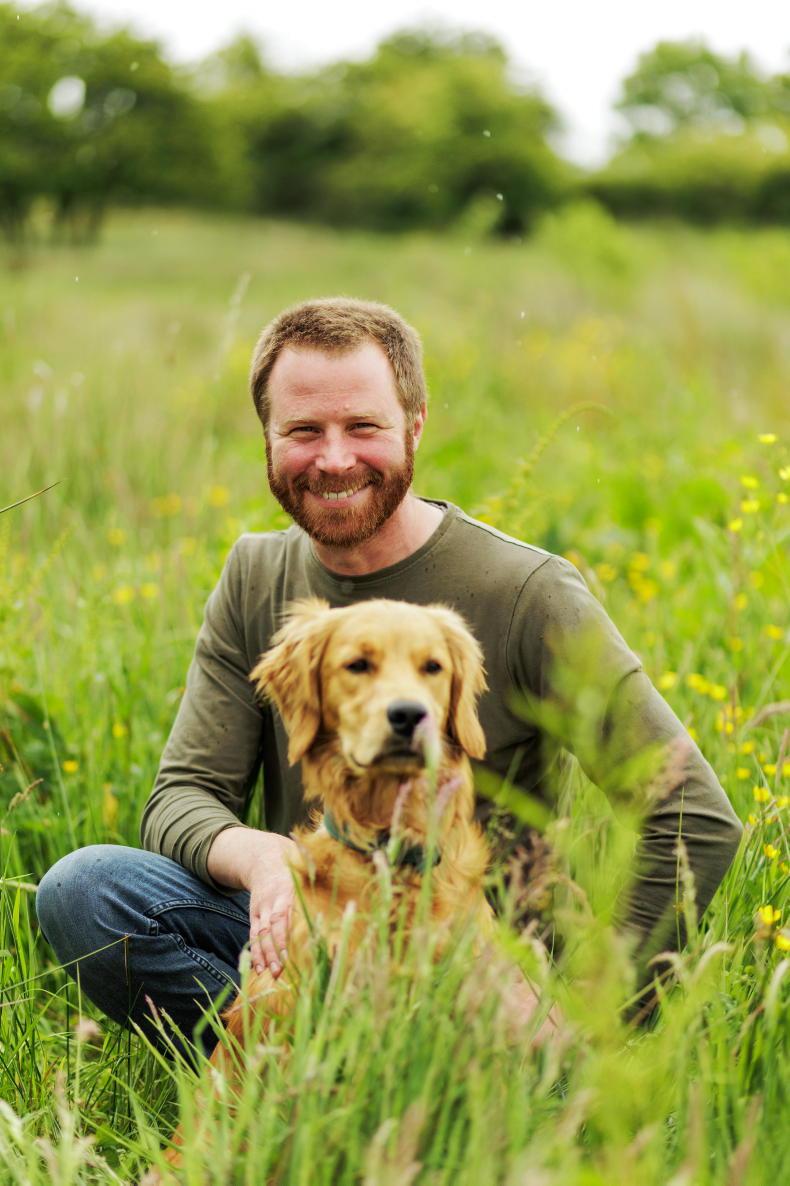
Planned holisitic grazing means James no longer reseeds, tops, spreads slurry or ploughs. He only makes a small amount of hay and silage / James Connolly
That said, farmers correctly using this method claim a better work-life balance, less stress, a good income from their product and a landscape which requires no chemical inputs, ploughing, topping, or any type of mechanical disturbance. I ask Clive what led him to start using Holistic Planned Grazing on his farm.
“I think you always have to question everything and take into your mind the bigger picture: is this good for the environment? Is it good for society? Is it good economically?
“None of what I do is philanthropic,” he adds. “I’m not trying to save the bees, for example, but that should follow if you’re managing your land holistically.
You’re letting nature do all your heavy lifting. My cows do everything themselves. I have a low stocking rate, but I’m producing a premium product at a low-input cost and use of energy. Not only is it profitable for me – it’s beneficial for the broader environment and our community.”
Maths and planning
This system requires a higher level of planning and organisation than the average organic farm. While Clive’s farm is certified organic (through the Organic Trust), he also undertook additional training for Holistic Planned Grazing.
“NOTS (the National Organic Training Skillnet) facilitate the online courses. There are four in total and each takes place over eight weeks,” he explains. “3LM, the Savory Hub for England and Ireland, deliver the training and – to be honest – the structure of the courses put me off for ages. It’s kind of expensive and can come off a bit ‘cultish’ – you work your way through tiers, or levels, of how enlightened you are!
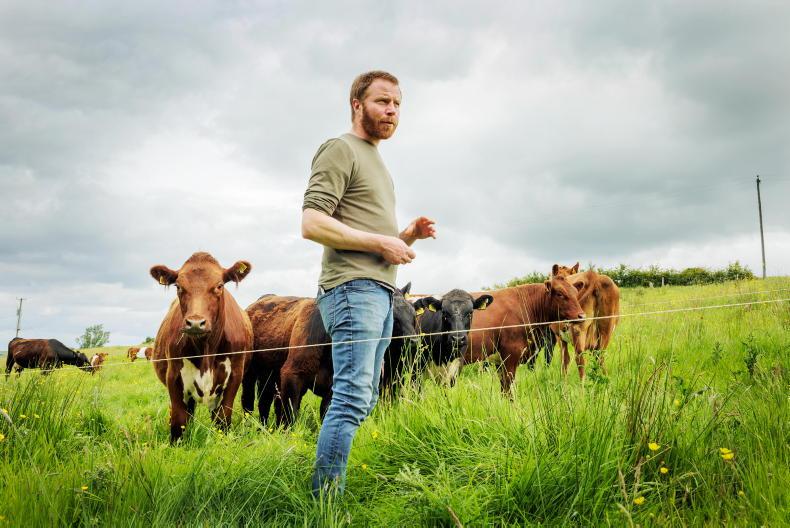
Planned Holistic Grazing is a system which takes into account ecology, animal welfare, the environment, profitability and the work-life balance of the farmer / James Connolly
“But in hindsight there’s no way you can learn it all without going through the steps,” he continues. “It’s complex and fewer than 5% of those trained in it actually follow through with practice – but it’s so powerful, the things you can do with it and the diversity of it.”
Application
Clive uses a mathematical algorithm (which he learned during his training) to set an acceptable grazing and recovery time for each of his grazing paddocks. He can then plan to have his herd in certain paddocks for specific times, which works with his lifestyle.
For example, this summer he is planning time away with his family, so his herd will be in his 15 hectare paddock which can be grazed for up to 20 days.
He often gives farm walks, speaks at events and he does some work with the Organic Trust in addition to farming.
He says he could be doing more and making more, but that he is happy with his level of productivity and income (his profit comes from direct selling his beef and additional trading and remains high due to his extremely low input costs).
“If my goals were different, I could spend more time working – have more input in different enterprises with chickens, etc. – have less family time and make loads more money. And I could still farm holistically, just with a different outcome.
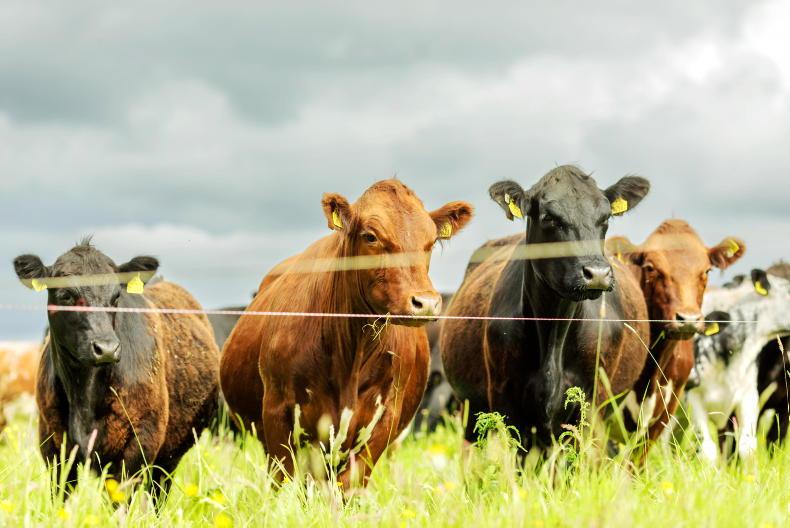
As he practises adapted breeding, Clive doesn't keep one breed of cattle - he currently keeps Irish Moiled, Belted Galloways and Angus Crosses, among others / James Connolly 15JUN22
This system takes time to learn, but it’s worthwhile. It gives you loads of control and flexibility.”
Breeding
An essential element of Clive’s farming success is the careful selection of his stock. He only keeps self-sufficient and calm animals.
“I aim to breed adapted animals,” he says. “Any animal which is a danger is gone straight away, as safety is a priority. Then the animals have to calve, rear a calf and get back into calf without any assistance. This year, they all calved within six weeks on their own – I did nothing. All I had to do was try and catch the calves in time to tag them.”
With this system, Clive doesn’t keep a specific breed. He currently farms a mix of Irish moiled, belted galloway, shorthorn and angus cross animals. He outwinters a large portion of his stock and houses his breeding stock for four months per year. He slaughters around 15 animals per year through a local abattoir/butcher.
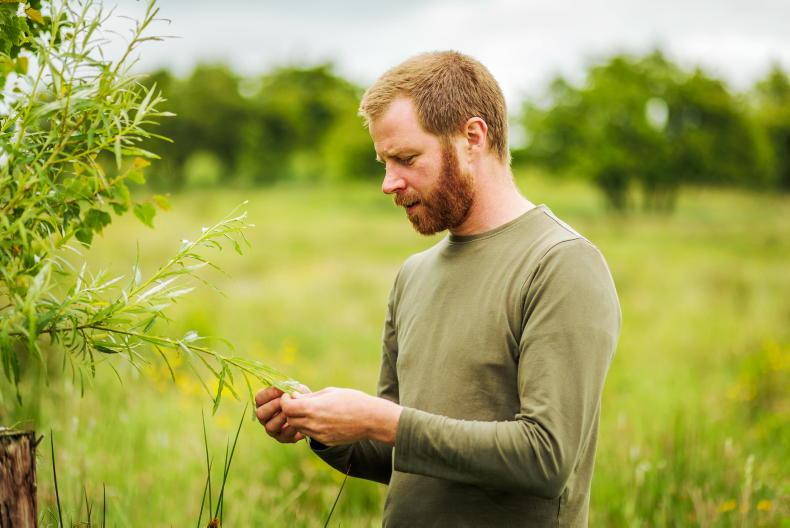
Clive practises agroforestry as he believes increasing tree cover on his farm will imrpove pasture growth, especially in marginal areas / James Connolly
“I buy stock from a few farmers – usually people I lend my bull to,” he says. “I buy back their bull calves just to bulk up my numbers. I was doing the sums and logistics of getting rid of the breeding herd. I could probably finish double the animals and out-winter everything, but it’s very hard to find the type of animals I want. That’s valuable enough to me to bother keeping the breeding herd.”
Agroforestry
Aside from the fact that Clive has stopped reseeding, topping, ploughing, spreading slurry and has only made a small amount of silage and hay this past year, he has also invested in agroforestry and is a founding member of the Irish Agroforestry Forum (IAF).
He says planting native tree species on his land makes sense as the trees can restore soil function and improve pasture growth, especially in marginal, rushier areas.
“A big problem with the current agroforestry scheme is that it is limited to a specific model with specific goals, whereas agroforestry has massive potential to deliver on a host of environmental and economic outcomes,” he says. “I think that’s going to change and we’ve been bringing to light these issues for the department. And they are being receptive; they’re looking for solutions.”
Overall, though he favours a shorter supply chain for his own farm enterprise, Clive doesn’t necessarily believe everyone needs to be selling this way. He feels, instead, that there is a place in the market for all kinds of farming systems.
“I’m not an economist, but I do think there’s a place for everything because diversity is good and, therefore, diversity in the market is also good. That said, I also think having local food sovereignty is really important and valuable. It creates resilience.”
See rareruminare.com for more
information
Read more
Is localisation and clever marketing the key to a sustainable future food model?
Can we create a food-secure future through gender equality?
I go against almost
all the advice on best practice given to farmers.” So Clive Bright tells me as we walk across a sloping field in the hills of Ardsallagh,
Co Sligo.
Clive farms a 120ac suckler-to-beef herd of between 35 to 50 animals. He farms using a method known as Holistic Planned Grazing; a unique system for farming with nature. He sells his beef through his business, Rare Ruminare, via direct sale.
From what he tells me, Clive has never been a “status quo” kind of guy, so it’s no wonder that when it came to his farm, he wanted to find his own way to make things work for himself, his family life (he has two children) and for nature.
Organic interest
“I remember being 12-ish [years of age] and getting the library in Ballymote to order me books on organic farming,” he chuckles. “Whether I had seen a feature about it on TV that inspired me or I don’t know what. But I was always interested in organic farming.”
Clive isn’t just a farmer though, he is also an artist. He studied textile design at the National College of Art and Design in Dublin and had a dream of getting his degree, moving home, getting his Green Cert and living his life both farming and creating art.
At the time, he wasn’t sure how this was going to work, but a chance meeting at 18 (while in hospital with appendicitis) grew his confidence and helped guide his future.

Clive Bright specialises in Planned Holistic Grazing for his beef herd at Rare Ruminaire Farm in Ardsallagh, Co. Sligo / James Connolly
“I met this goldsmith, Erwin Springbrunn, who had pretty much the same formula [art and farming],” he says. “I wanted to be an organic farmer and this guy was an organic farmer and a goldsmith. He was doing exactly what I planned to do, so it was really cool.”
Making the switch
Clive has been farming organically (and with holistic principles) for years, but in 2020, he did formal training in Holistic Planned Grazing and now says he would never look back.
“Previously, I would say my farm was holistic, but it was actually mob grazing and I was adjusting my paddocks all the time,” he explains. “The cattle were healthy but I hit the stage where my productivity was dropping slightly – now it doesn’t; the pastures are pumping with growth all the time.
“The thing about Holistic Planned Grazing is you’re constantly monitoring,” he continues. “You’re monitoring plant density, so the amount of time the cattle are in [the paddock] has an effect and the amount of recovery time also has an effect.

Clive practices adapted breeding, which means he only keeps stock with calm temperaments and those which are self-sufficient / James Connolly
If my recovery is too long at the wrong time of year, none of the new plants have a chance to grow. You have to get the timing right to grow as much grass as you can and allow for all that diversity.”
Holistic Planned Grazing
Holistic Planned Grazing was developed in the 1960s by an African-based biologist named Alan Savory. He found that, while rotational grazing works well for livestock management, it didn’t necessarily provide ecological benefits (especially in southern Africa, where desertification is a problem).
This grazing management system takes animal welfare, nature and productivity into account while adhering to the following principles:
- A necessary understanding of the mutual relationship between humans, animals and the land.
- Enough on-farm flexibility to respond to nature’s ever-changing landscape.
- The idea that, if your farming style mimics nature well enough, animal husbandry can act as a substitute for original grazing herds which might now be lost.
- Understanding that timing is everything – knowing when to graze a certain field, and for how long, is crucial to this agricultural system.
- Monitoring all decisions, and assessing their impact on the four ecosystem processes (watercycle, mineral cycle, energy flow and community dynamics).
Benefits for farmers
Some of Savory’s teachings have been refuted by scientists – for example, he stated in a TED Talk that his method can bring carbon levels back to pre-industrial levels, which some scientists refute.

Planned holisitic grazing means James no longer reseeds, tops, spreads slurry or ploughs. He only makes a small amount of hay and silage / James Connolly
That said, farmers correctly using this method claim a better work-life balance, less stress, a good income from their product and a landscape which requires no chemical inputs, ploughing, topping, or any type of mechanical disturbance. I ask Clive what led him to start using Holistic Planned Grazing on his farm.
“I think you always have to question everything and take into your mind the bigger picture: is this good for the environment? Is it good for society? Is it good economically?
“None of what I do is philanthropic,” he adds. “I’m not trying to save the bees, for example, but that should follow if you’re managing your land holistically.
You’re letting nature do all your heavy lifting. My cows do everything themselves. I have a low stocking rate, but I’m producing a premium product at a low-input cost and use of energy. Not only is it profitable for me – it’s beneficial for the broader environment and our community.”
Maths and planning
This system requires a higher level of planning and organisation than the average organic farm. While Clive’s farm is certified organic (through the Organic Trust), he also undertook additional training for Holistic Planned Grazing.
“NOTS (the National Organic Training Skillnet) facilitate the online courses. There are four in total and each takes place over eight weeks,” he explains. “3LM, the Savory Hub for England and Ireland, deliver the training and – to be honest – the structure of the courses put me off for ages. It’s kind of expensive and can come off a bit ‘cultish’ – you work your way through tiers, or levels, of how enlightened you are!

Planned Holistic Grazing is a system which takes into account ecology, animal welfare, the environment, profitability and the work-life balance of the farmer / James Connolly
“But in hindsight there’s no way you can learn it all without going through the steps,” he continues. “It’s complex and fewer than 5% of those trained in it actually follow through with practice – but it’s so powerful, the things you can do with it and the diversity of it.”
Application
Clive uses a mathematical algorithm (which he learned during his training) to set an acceptable grazing and recovery time for each of his grazing paddocks. He can then plan to have his herd in certain paddocks for specific times, which works with his lifestyle.
For example, this summer he is planning time away with his family, so his herd will be in his 15 hectare paddock which can be grazed for up to 20 days.
He often gives farm walks, speaks at events and he does some work with the Organic Trust in addition to farming.
He says he could be doing more and making more, but that he is happy with his level of productivity and income (his profit comes from direct selling his beef and additional trading and remains high due to his extremely low input costs).
“If my goals were different, I could spend more time working – have more input in different enterprises with chickens, etc. – have less family time and make loads more money. And I could still farm holistically, just with a different outcome.

As he practises adapted breeding, Clive doesn't keep one breed of cattle - he currently keeps Irish Moiled, Belted Galloways and Angus Crosses, among others / James Connolly 15JUN22
This system takes time to learn, but it’s worthwhile. It gives you loads of control and flexibility.”
Breeding
An essential element of Clive’s farming success is the careful selection of his stock. He only keeps self-sufficient and calm animals.
“I aim to breed adapted animals,” he says. “Any animal which is a danger is gone straight away, as safety is a priority. Then the animals have to calve, rear a calf and get back into calf without any assistance. This year, they all calved within six weeks on their own – I did nothing. All I had to do was try and catch the calves in time to tag them.”
With this system, Clive doesn’t keep a specific breed. He currently farms a mix of Irish moiled, belted galloway, shorthorn and angus cross animals. He outwinters a large portion of his stock and houses his breeding stock for four months per year. He slaughters around 15 animals per year through a local abattoir/butcher.

Clive practises agroforestry as he believes increasing tree cover on his farm will imrpove pasture growth, especially in marginal areas / James Connolly
“I buy stock from a few farmers – usually people I lend my bull to,” he says. “I buy back their bull calves just to bulk up my numbers. I was doing the sums and logistics of getting rid of the breeding herd. I could probably finish double the animals and out-winter everything, but it’s very hard to find the type of animals I want. That’s valuable enough to me to bother keeping the breeding herd.”
Agroforestry
Aside from the fact that Clive has stopped reseeding, topping, ploughing, spreading slurry and has only made a small amount of silage and hay this past year, he has also invested in agroforestry and is a founding member of the Irish Agroforestry Forum (IAF).
He says planting native tree species on his land makes sense as the trees can restore soil function and improve pasture growth, especially in marginal, rushier areas.
“A big problem with the current agroforestry scheme is that it is limited to a specific model with specific goals, whereas agroforestry has massive potential to deliver on a host of environmental and economic outcomes,” he says. “I think that’s going to change and we’ve been bringing to light these issues for the department. And they are being receptive; they’re looking for solutions.”
Overall, though he favours a shorter supply chain for his own farm enterprise, Clive doesn’t necessarily believe everyone needs to be selling this way. He feels, instead, that there is a place in the market for all kinds of farming systems.
“I’m not an economist, but I do think there’s a place for everything because diversity is good and, therefore, diversity in the market is also good. That said, I also think having local food sovereignty is really important and valuable. It creates resilience.”
See rareruminare.com for more
information
Read more
Is localisation and clever marketing the key to a sustainable future food model?
Can we create a food-secure future through gender equality?







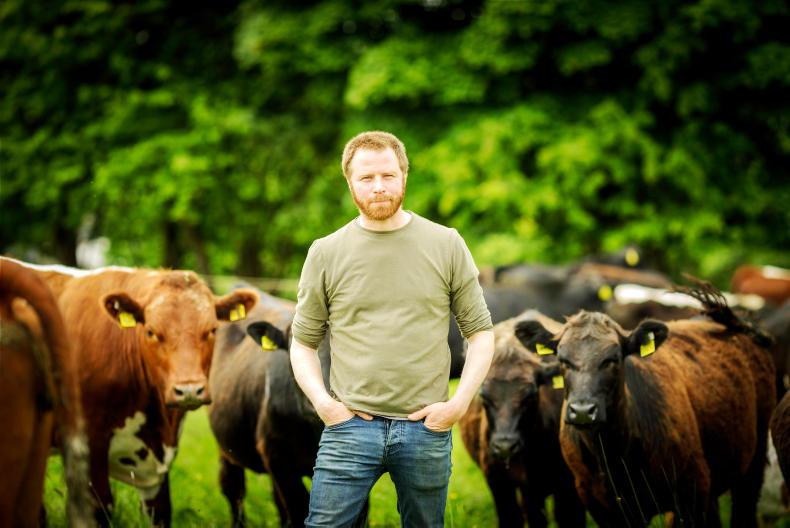




 This is a subscriber-only article
This is a subscriber-only article










SHARING OPTIONS: